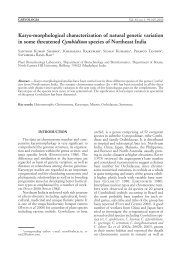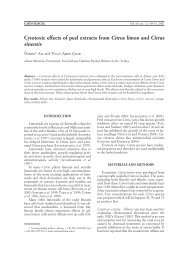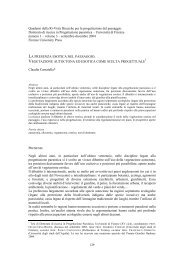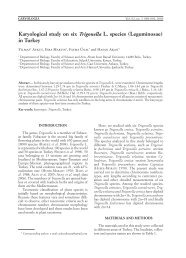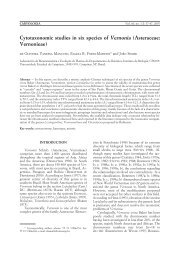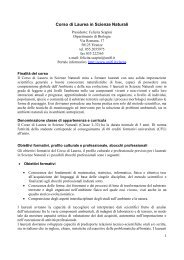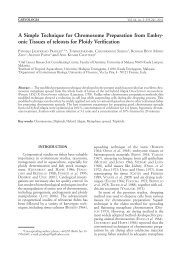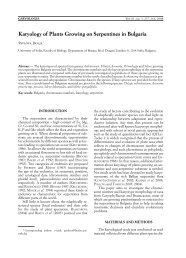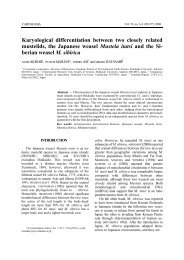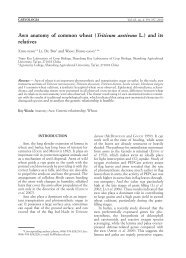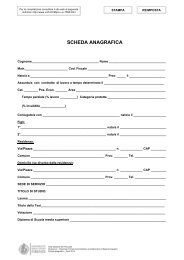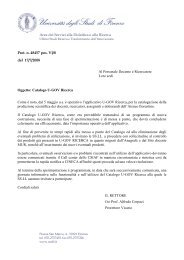A revised cytotaxonomy of the genus Tulbaghia (Alliaceae)
A revised cytotaxonomy of the genus Tulbaghia (Alliaceae)
A revised cytotaxonomy of the genus Tulbaghia (Alliaceae)
Create successful ePaper yourself
Turn your PDF publications into a flip-book with our unique Google optimized e-Paper software.
100<br />
A<br />
Fig. 22a — Diagrammatic representation <strong>of</strong> <strong>the</strong> six nucleolar<br />
chromosome types (N.O.R.'s) in <strong>Tulbaghia</strong> drawn according to<br />
<strong>the</strong>ir relative size.<br />
Type A: occurs in 13 species and is a medium sized chromosome<br />
with a submedian centromere and with <strong>the</strong> N.O.R. located<br />
in an intercalary position.<br />
Type B: occurs, in combination with type A, only in one species<br />
(T. acutiloba Harv.) and is <strong>the</strong> second longest <strong>of</strong> <strong>the</strong> complement:<br />
<strong>the</strong> N.O.R. is located in <strong>the</strong> short arm in an intercalary<br />
position.<br />
Type C: occurs in two species (T. capensis L. and T. alliacca L.<br />
f.) and is a subterminal chromosome and <strong>the</strong> second longest <strong>of</strong><br />
<strong>the</strong> karyotype. The N.O.R. is located distally on <strong>the</strong> short arm.<br />
Type D: occurs in five species and is usually <strong>the</strong> shortest <strong>of</strong> <strong>the</strong><br />
complement with a subterminal centromere. The N.O.R. is located<br />
terminally on <strong>the</strong> short arm and <strong>of</strong>ten carries an heterochromatic<br />
"satellite" <strong>of</strong> various sizes.<br />
Type E: occurs in one species (T. montana Vosa) and is a medium<br />
sized chromosome with a submedian centromere. The<br />
N.O.R. is located terminally on its long arm. Type F: occurs, in<br />
combination with type A, in two species (T. rhodesica Fries and<br />
T. cameroni Baker) and is <strong>the</strong> longest <strong>of</strong> <strong>the</strong> complement with a<br />
submedian centromere: <strong>the</strong> N.O.R. is located in an intercalary<br />
position very near <strong>the</strong> centromere.<br />
Fig. 22b — Diagrammatic representation <strong>of</strong> <strong>the</strong> haploid karyotypes<br />
<strong>of</strong> <strong>Tulbaghia</strong>. One species for each karyotype is illustrated<br />
and drawn in accordance with its relative size). Group 1:<br />
T. capensis L. (karyotype C); Group 2: T. dregeana Kunth<br />
(karyotype A); Group 3: T. transvaalensis Vosa (karyotype AA);<br />
Group 4: T. acutiloba Harv. (karyotype AB); Group 5: T. coddii<br />
Vosa & Burbidge (karyotype D); Group 6: T. montana Vosa<br />
(karyotype E); Group 7: T. rhodesica Fries (karyotype AF).<br />
VOS




